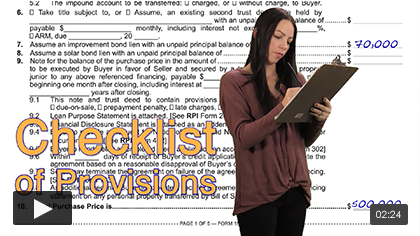This is the second episode in our series covering purchase agreement types and variations. The prior episode defines the different types of purchase agreements, and illustrates a broker’s freedom to use any purchase agreement contract they choose.
The purchase agreement in practice
A buyer’s agent uses a purchase agreement
The pricing and terms for performance are limited to conventional financing, a takeover of existing mortgages, a carryback note or a combination of some of these arrangements.
This purchase agreement is also properly used by sellers when confronted with a counteroffer
On acceptance, the purchase agreement becomes a binding written contract between the buyer and seller. To be enforceable, the price and terms for performance need to be clear, concise and complete to prevent misunderstandings.
To this end, a comprehensive purchase agreement includes as “boilerplate” all provisions that might be needed in a likely transaction. They are designed to serve as a checklist of provisions an agent is to consider when preparing an offer. The various conventional financing arrangements and conditions a prudent buyer considers when making an offer to purchase a home are tightly worded for easy selection.
Escrow instructions provide yet another variation on the purchase agreement. For example, a buyer and seller having orally agreed on the terms of a sale, with or without the assistance of an agent, contact an escrow company to handle their deal. Escrow instructions are prepared and signed, without first entering into a real estate purchase agreement. Here, the escrow instructions bind the buyer and seller as though they had entered into a purchase agreement. [See RPI Form 401]
Countering an unacceptable offer
To counter an unacceptable purchase agreement offer by the buyer, the seller’s agent may:
- Prepare the seller’s offer on a new purchase agreement form. No reference is made in the seller’s new offer to the rejected purchase agreement offer previously submitted by the buyer. This new original offer prepared by the seller’s agent is signed first by the seller and the seller’s agent, then submitted to the buyer for the buyer’s acceptance or rejection. [See RPI Form 150]
- Prepare the seller’s offer on a counteroffer form which includes, by reference, the terms and conditions of the buyer’s offer. Modifications are then entered on the counteroffer form stating the terms and conditions sought by the seller which are different from those in the buyer’s offer that are unacceptable to the seller. [See RPI Form 180]
- Dictate escrow instructions based on an agreement orally negotiated with the buyer (or buyer’s agent) to resolve the seller’s dissatisfaction regarding the terms and conditions in the buyer’s offer. The instructions are submitted to the seller and buyer for signatures. On receipt by escrow of copies of the instructions containing the signatures of all parties, the escrow instructions then become the only agreement entered into by both the buyer and seller. Here, the escrow company becomes a sort of secretarial service used by agents who do not take the time to prepare a written counteroffer. [See RPI Form 401]
- Alter the buyer’s original written offer by deleting unacceptable provisions from the face of the document and entering the differing provisions sought by the seller, a process called deface and interlineate. The altered purchase agreement is then signed by the seller in the acceptance provision and returned to the buyer as the seller’s counteroffer. This counteroffer and acceptance procedure is called change-and-initial, and is used when a counteroffer form is not made available and prepared by the seller’s agent.
- Set up an auction environment (if the current market is composed of too many buyers for too little inventory) by calling for the submission of all offers on a date and at a time set for the seller to accept the best offer presented by prospective buyers, or by creating some other auction situation short of the seller signing multiple counteroffers, an awkward (and typically misguided) response to the receipt of multiple purchase offers.
- Orally advise the buyer’s agent about the changes required before the seller accepts the buyer’s offer. If the buyer is interested in the property based on those changes, the buyer’s agent is asked to prepare and submit a new purchase agreement offer signed by the buyer for the seller to consider. This situation requires the buyer to “negotiate with themselves,” while the seller remains uncommitted to sell on any terms. Here, either the seller’s agent does not take the time to prepare a counteroffer stating the seller’s terms and conditions, or the seller does not want to become uncommitted.
- Let the offer expire, then resume negotiations with the buyer and their agent if the buyer still has an interest in the property.
Related video:
A rejection occurs by delivering a written rejection stating no counteroffer will be forthcoming, as provided at the end of most purchase agreement forms, or by submitting a counteroffer. After a rejection has been communicated, the original offer can no longer be accepted to form a binding agreement. [See RPI Form 184]
The rejection on receipt of a purchase agreement offer by preparing and submitting a counteroffer takes place in one of two circumstances:
- The use of a counteroffer form with wording that incorporates all the terms in the offer submitted which are then modified by entering alternative or additional provisions on the counteroffer form; or
- The use of a different purchase agreement form to prepare an entirely new offer which is submitted as a counteroffer.


















